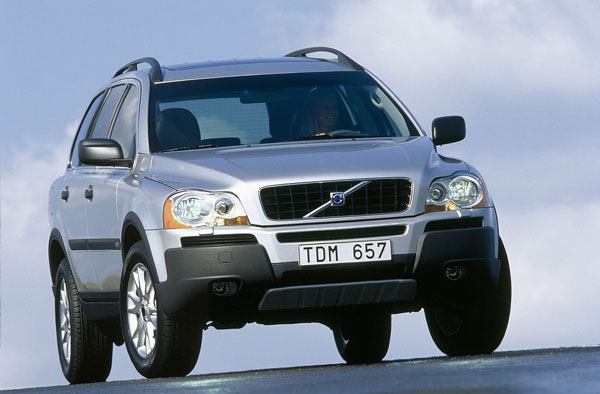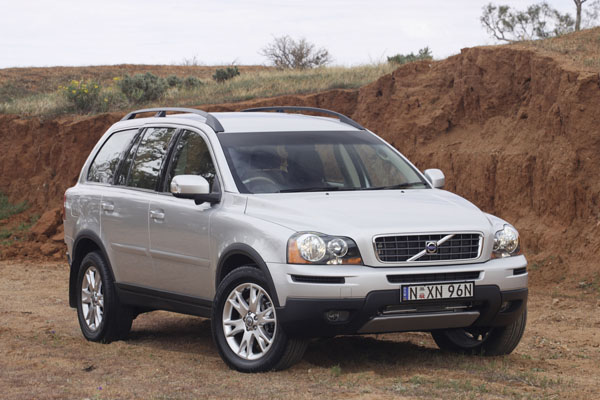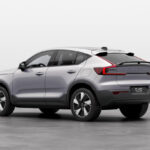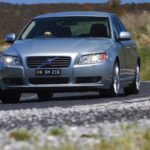The Volvo XC90 is more of a people mover than an SUV. Which makes sense because very few SUV buyers fall into the ‘I dream of crossing the Simpson Desert one day’ category. It was launched here in August 2003 and wasn’t discontinued until August 2015, albeit with several makeovers during that 12 year period.
The XC90 has a big emphasis on space and comfort. The cabin sits well forward thanks to the use of a transversely mounted engine instead of the longitudinal units used by most large SUVs.
A disadvantage of the cab-forward layout is that the front wheelarch intrudes into the front passenger’s footwell, making it rather narrow.
Volvo assures us there are no fewer than 64 seating/luggage combinations. The centre seat in the second row can be moved forward until it almost touches the two front seats. This brings a young child within easy reach of the two front occupants. The seat even has a built-in child seat that can be set up in a few seconds.
With the exception of the driver’s, all seats can be folded flat. Making it suitable for carrying long items such as ladders and surfboards.
The rear-seat squabs slide under the rear luggage area to minimise the space they take up when the seats are folded down.
A practical feature of the body design is large areas of plastic protection strips, just the thing for reducing damage caused in shopping centre carparks. Or even when you squeeze through narrow bush trails if you’re one of the few who take a Volvo XC90 to explore the Aussie bush.
Power is normally taken only to the front wheels, with the rear wheels coming into play if the fronts begin to lose traction. An off-road 4WD it’s not, but the big Volvo XC90 wagon can be taken fair distances from sealed surfaces if driven sensibly.
On sealed roads the ride is good while the steering and suspension work well. The XC90 isn’t the most nimble of vehicles, but it hangs on well in corners and you are protected by electronic traction controls. This includes a program that helps resist vehicle rollover.
Power was originally provided by a choice between two petrol engines – one a five-cylinder 2.5-litre turbocharged unit, the other a twin-turbo straight-six of 3.0 litres.
In October 2006, Volvo introduced a heavily revised XC90 featuring a facelift and the option of a 4.4-litre petrol V8 engine as well as a 2.4-litre turbo-diesel.
In April 2007 the straight-six 3.0-litre engine was expanded to 3.2 litres. The larger engine has less power than the smaller, but the wider spread of torque makes up for this. The five-cylinder unit was discontinued at the end of that year.
Transmissions are all automatics, with four-speed and five-speed units in earlier models and six ratios from 2007 onwards.
Power is normally taken only to the front wheels, with the rear wheels coming into play if the fronts begin to lose traction.
On sealed roads the ride is good and the steering and suspension work well. The XC90 isn’t the most nimble of vehicles, but it hangs on safely.
Electronic traction controls were there from the start of XC90 production; including a program that helps resist vehicle rollover. The later the XC90 model the more safety features are incorporated.
Volvo is long established in Australia with a dealer network that covers all metro areas as well as quite a few country centres.
Service, repair and parts costs for the XC90 are about average for a vehicle in this class and we have heard of no real complaints about the availability of spares.
Check on insurance costs as there’s a bigger than average spread in premium charges. As always when doing comparisons make sure you’re doing a like-for-like survey.
WHAT TO LOOK FOR
Very few XC90s are taken off-road but if you do come across one with scratches on the lower bumper corners and the door sills it has probably belonged to an adventurous family.
Engine oil and filter changing is important on any turbocharged engine, check the service books. Ideally the work should have been done by an authorised Volvo dealer, but there are some high quality specialists who understand the vehicle well.
Listen for suspension noises, especially on rougher roads, there’s no need to find a dirt road for this. Sadly, many suburban roads will suffice.
Look over the body for signs of damage or crash repairs. Mismatched paint, ripples in panels when viewed end on, and paint spots on glass, badges and other non-paint areas are easy to spot.
The left-front wheel and tyre are often the first areas to suffer if a driver makes mistakes whilst parking.
Automatic transmissions should be smooth and all but imperceptible on their changes at low throttle openings. Some shift feel at big openings is acceptable, but too much may indicate auto problems.
CAR BUYING TIP
Family wagons may suffer from kids’ behaviour. So it’s important to check every inch of the interior just as carefully as the outside areas.














